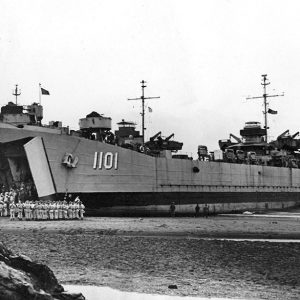calsfoundation@cals.org
USS Saline County (LST-1101)
The USS Saline County (LST-1101) was an LST-542 Class tank landing ship built in 1944 that saw service in World War II and the Korean War. It was designated the USS Saline County on July 1, 1955, in honor of counties in five U.S. states, including Arkansas.
LST-1101 was one of a class of vessels—called Landing Ship, Tank—created to carry tanks, wheeled and tracked vehicles, artillery, construction equipment, and supplies during military operations along coastal areas. Called “Large Slow Targets” by their crews, they were designed as shallow-draft vessels; when carrying a 500-ton load, LST-1101 drew only three feet eleven inches forward and nine feet ten inches aft. They carried pontoons amidships that could be used to create causeways when they had to debark their cargos from deeper water, but they were capable of dropping their forward ramps directly onto a beach.
LST-1101’s keel was laid down on November 22, 1944, by the Missouri Valley Bridge and Iron Company of Evansville, Indiana, and the ship was launched on January 3, 1945. LST-1101 weighed 1,625 tons, was 328 feet long and fifty feet wide, and could reach speeds of 11.6 knots. It carried a crew of thirteen officers and 104 men, and could transport sixteen officers and 147 soldiers. LST-1101 was armed with two twin 40mm guns, four single 40mm guns, and twelve single 20mm guns. The vessel was put under reduced commission on January 20 prior to being taken down the Mississippi River. The vessel was formally commissioned on January 26, 1945, under the command of Lieutenant James M. Troutman Jr.
LST-1101 had its shakedown cruise (a test of the ship’s performance) in the Gulf of Mexico and, after loading its hold with asphalt and pontoons, departed for the Pacific on March 3, 1945. After crossing the ocean in convoy, the vessel arrived at Pearl Harbor on April 4. LST-1101 took on passengers on April 16 and sailed to Guam to deliver the load of asphalt in early May; it then disembarked its passengers on Saipan. After taking on a load of replacement troops, it headed for the Ryukyu Islands. After surviving drifting mines and a typhoon, it arrived at Okinawa on June 8.
On July 10, LST-1101 loaded men and equipment of the Sixth Marine Division and delivered them on Guam before proceeding to the Philippines to pick up men of the 895th Chemical Warfare Company, who were disembarked on Ie Shima on August 12. The war having ended, LST-1101 returned to the Philippines for a load of occupation troops, who were delivered at Yokohama on September 15. The vessel shuttled men and equipment from Okinawa to mainland Japan before returning to Hawaii to take on veterans for return to the United States in November. After delivering them in California in January 1946, the vessel proceeded to Seattle, Washington, where it was decommissioned on June 6 and placed in the Pacific Reserve Fleet.
LST-1101 was recommissioned for service in the Korean War in August 1950 and trained in California waters in January 1951 before sailing west. It arrived at Yokosuka, Japan, on March 23 before loading men and vehicles of Company A, 101st Signal Battalion, delivering them to Inchon, Korea, on April 8. With the exception of one run to Korea, it primarily operated among the Japanese islands, delivering cargo and conducting amphibious exercises through the summer before returning to Korea in September. The vessel transported South Korean troops along the peninsula in early September, then made shuttle runs between Pusan and the prisoner-of-war island of Koje-Do. It returned to Japan on October 29, leaving there for the United States in late November.
Arriving at San Diego, California, on December 19, LST-1101 operated in California waters through 1952. It left again for Korea on January 3, 1953, arriving at Yokosuka on February 7 and then heading to Pusan on March 12 for operations on the peninsula and surrounding islands. On April 20, LST-1101 took part in Operation Little Switch, delivering sick and wounded communist troops from Koje-Do to Pusan for repatriation to North Korea. It operated around Korea and Japan before sailing back to San Diego in late November.
Named the USS Saline County on July 1, 1955, the vessel sailed with the First and Seventh Fleets in the western Pacific until late 1958. The Saline County conducted shuttle runs to Alaska in 1959 and was deactivated in 1960, having earned one battle star in World War II and five in Korea. The Saline County was decommissioned on March 9, 1960. It was transferred to the German navy in 1960, where it was converted to serve as a mine layer, the Bottrop, and struck from the naval list on November 1. The vessel was transferred to the Turkish navy on December 12, 1972, serving as the Bayraktar. Its present status is unknown.
For additional information:
“LST-1101 Saline County.” Dictionary of American Naval Fighting Ships. https://www.hazegray.org/danfs/amphib/lst1101.htm (accessed June 13, 2018).
Rottman, Gordon L. Landing Ship, Tank (LST) 1942–2002. Oxford, UK: Osprey Publishing Co., 2005.
Silverstone, Paul. The Navy of the Nuclear Age, 1947–2007. New York: Routledge, 2009.
“USS Saline County (LST-1101).” NavSource.org. https://www.navsource.org/archives/10/16/161101.htm (accessed June 13, 2018).
Mark K. Christ
Little Rock, Arkansas
 Military
Military World War II through the Faubus Era, 1941 through 1967
World War II through the Faubus Era, 1941 through 1967 USS Saline County
USS Saline County 




Comments
No comments on this entry yet.